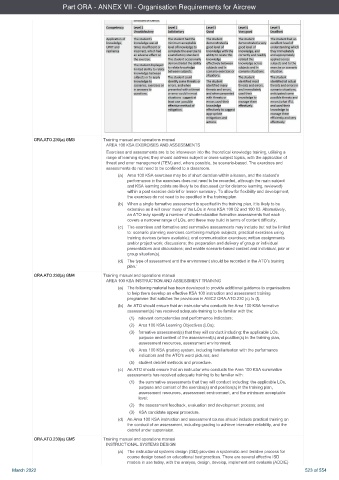Page 523 - UK AirCrew Regulations (Consolidated) March 2022
P. 523
Part ORA - ANNEX VII - Organisation Requirements for Aircrew
ORA.ATO.230(a) GM3 Training manual and operations manual
AREA 100 KSA EXERCISES AND ASSESSMENTS
Exercises and assessments are to be interwoven into the theoretical knowledge training, utilising a
range of learning styles; they should address subject or cross-subject topics, with the application of
threat and error management (TEM) and, where possible, be scenario-based. The exercises and
assessments do not need to be confined to a classroom.
(a) Area 100 KSA exercises may be of short duration within a lesson, and the student’s
performance in the exercises does not need to be recorded, although the main subject
and KSA learning points are likely to be discussed (or for distance learning, reviewed)
within a post exercise debrief or lesson summary. To allow for flexibility and development,
the exercises do not need to be specified in the training plan.
(b) When a single formative assessment is specified in the training plan, it is likely to be
extensive as it will cover many of the LOs in Area KSA 100 02 and 100 03. Alternatively,
an ATO may specify a number of shorter-duration formative assessments that each
covers a narrower range of LOs, and these may build in terms of content difficulty.
(c) The exercises and formative and summative assessments may include but not be limited
to: scenario planning exercises combining multiple subjects; practical exercises using
training devices (where available); oral communication exercises; written assignments
and/or project work; discussions; the preparation and delivery of group or individual
presentations and discussions; and enable scenario-based content and individual, pair or
group situation(s).
(d) The type of assessment and the environment should be recorded in the ATO’s training
plan.’
ORA.ATO.230(a) GM4 Training manual and operations manual
AREA 100 KSA INSTRUCTION AND ASSESSMENT TRAINING
(a) The following material has been developed to provide additional guidance to organisations
to help them develop an effective KSA 100 instruction and assessment training
programme that satisfies the provisions in AMC2 ORA.ATO.230 (c) to (f).
(b) An ATO should ensure that an instructor who conducts the Area 100 KSA formative
assessment(s) has received adequate training to be familiar with the:
(1) relevant competencies and performance indicators;
(2) Area 100 KSA Learning Objectives (LOs);
(3) formative assessment(s) that they will conduct including: the applicable LOs,
purpose and content of the assessment(s) and position(s) in the training plan,
assessment resources, assessment environment;
(4) Area 100 KSA grading system, including familiarisation with the performance
indicators and the ATO’s word pictures; and
(5) student debrief methods and procedure.
(c) An ATO should ensure that an instructor who conducts the Area 100 KSA summative
assessments has received adequate training to be familiar with:
(1) the summative assessments that they will conduct including: the applicable LOs,
purpose and content of the exercise(s) and position(s) in the training plan,
assessment resources, assessment environment, and the minimum acceptable
level;
(2) the assessment feedback, evaluation and development process; and
(3) KSA candidate appeal procedure.
(d) An Area 100 KSA instruction and assessment course should include practical training on
the conduct of an assessment, including grading to achieve inter-rater reliability, and the
debrief under supervision.
ORA.ATO.230(a) GM5 Training manual and operations manual
INSTRUCTIONAL SYSTEMS DESIGN
(a) The instructional systems design (ISD) provides a systematic and iterative process for
course design based on educational best practices. There are several effective ISD
models in use today, with the analyse, design, develop, implement and evaluate (ADDIE)
March 2022 523 of 554

